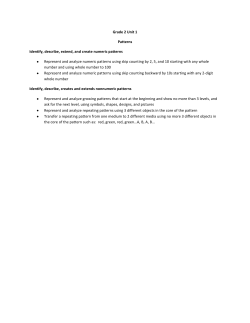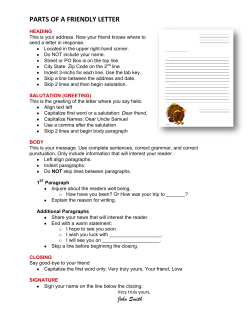
VOLUME 2 CONTENTS
1 VOLUME 2 CONTENTS Unit 1: Learning the Staff Keeping the focus on the page Getting Students to do Written Work Lines and Spaces Comparing notes on the staff Ledger Lines 1 (small lines added below the staff) Reveille Mystery Song – “On Top of Spaghetti” Double Skips (keyboard) Identifying steps and skips (keyboard) Unit 2: More Fingering Stretched Root Position Kum Ba Ya O Susannah Low Second Inversion Reveille Clementine Review: Home and Away Chords Combining the Staff with Chords Clementine with chords O Christmas Tree Dreidel Song Old McDonald Sneak peek: The “Reach” (F) Chord Three-chord songs to get started: When the Saints Go Marching In The Lion Sleeps Tonight Unit 3: More Notes C-Sharp I've Been Workin' on the Railroad Yankee Doodle Boy D-Sharp You Are My Sunshine Unit 4: Toward Fluent Reading Steps and Skips on the Staff Marking Skips When the Saints Go Marching In The Marines' Hymn The Wheels on the Bus Yankee Doodle Cockles and Mussels High C I'm a Little Teapot F-Sharp Head, Shoulders, Knees and Toes Playing Tricks More Thumb Crossing Scales E-Flat Theory 101: Why use a sharp instead of a flat? Unit 5: Rhythmic Fluency Types of Rests You Are My Sunshine - revisited A Short Hold: The “Dot” Theory 101: Beats and Half-Beats Unit 6: Repeats and Endings O Susannah 3 Unit 7: Return to Chords Review: The Home and Away Chords Three-Note Chords Fingering for the Chords Getting to the Chord Ahead of Time Tips for Chord Playing More Two-Chord Songs: Wheels on the Bus Cockles and Mussels Three-Chord Songs: The “Reach” (F) Chord Theory 101: Triads and Seventh Chords; Chord Inversions Three-chord songs to get started: Yankee Doodle The Lion Sleeps Tonight (caribbean rhythm) O Susannah Kum Ba Ya Unit 8: Reading Review The Low Staff Region Deep in the Heart of Texas Unit 9: Where Do We Go from Here The Da Capo and Fine Theory/History 101: “Why these funny words?” – “Piano” is Italian Playing from Other Song Books 4 Introduction to Volume 2 Moving Ahead In Volume 1, we learned to play many melodies and began exploration of chords. We began to familiarize students with visual representations of melodic patterns, bearing some resemblance to the traditional notes on a staff. Now we begin to “mainstream” them by teaching, one by one, the elements of standard music notation, including at every step songs that will be enjoyable and rewarding. Since the core of western music is based on three chords, we take students to the verge of being able to play hundreds of songs of their own choosing. Yet the goal is to guide and simplify. Ultimately, we want students to be able to pick up a song in “lead sheet” or “fake book” format, and write in their own “helps,” making modifications, adding letters, whatever is effective. This way, the student “owns” the process of learning. They acknowledge their own learning style and needs; the instructor/method becomes merely a resource, and the student becomes his/her own teacher. As the saying goes, “give a man a fish, and he’ll eat for a day; teach him to fish, and he’ll eat for a lifetime.” We’ll continue this transition in Volume 3, and also go further with various fluency techniques. For these first two volumes we have not burdened the student with complicated fingering; however, fingering can often be the make-or-break, especially in fast songs. Fingering is also sometimes the only way to achieve the right rhythm. For students talented and diligent enough to persevere through the first two volumes, we owe it to them to push harder and give them the tools to achieve more. For now, however, we simply want students to experience more of the joy of music making. Have fun! Jumping Around If your student proved to be adventurous and a quick study, you may have moved ahead into this second volume before all of the material in Volume 1 was complete. While some of the exercises from the first book may have been redundant and unnecessary for the higher-functioning student, others may be worth revisiting, especially some of the simpler songs, which can be used either as a “breather” when the student seems overwhelmed with harder work, or as material to improvise on, practice changing keys, changing chords, etc. 5 For certain songs introduced in Volume 1, while the notes may have been manageable, the chords were postponed for lack of an adequate chord “repertoire.” You will likewise find that some songs introduced in this volume will be revisited for additional chords in Volume 3. For the Technically Minded This volume introduces “Theory 101” sidebars which explain some of the technical details about how chords are constructed and why notation functions as it does. These are without doubt optional and may far overwelm many students. However, others may thrive on this information and your main challenge will be to keep him on track with actually playing the music. Of course, music theory is itself a valid field of study with many applications. Whatever aspect of music captures the heart of your student, this book will have served its purpose. 6 Lines and Spaces Notes can be on lines or spaces. Each line tells you to play its own key on the keyboard. Each space also has its own key. Practice with lines and spaces 1. Lay this page flat 2. Put a penny on each line 3. Put a penny in each space 4. Put a penny on a line and move it to the next line. This is a SKIP 5. Put a penny on the bottom line (E); then move it to the space between the bottom and second line. This is a STEP 6. Put a penny on a space and move it to the next space. This is a SKIP 7. Put a penny on the first space (F); then move it to the first line (E) This is a STEP 7 On each staff, tell whether the two notes are the same or different 8 Tell whether each note is on a line or in a space. Hint: With hollow notes, you can look inside the note. If it has a line inside, it is on a line (of course this does not work with dark notes) 9 REVEILLE Play only the NOTES IN BLACK. Do Not play the gray notes. P/E: You might try saying the following: "play – tiptoe-tiptoe – play...", etc. "Tiptoe" means to brush the fingers over the keys without pressing them down. 10 Mystery Song 1. Color the “in-between” notes gray 2. Play the song 3. Can you guess the title? 11 How far apart are the notes? E G __Step __Single Skip __Double Skip B E F __Step __Single Skip __Double Skip B __Step __Single Skip __Double Skip E A __Step __Single Skip __Double Skip F D __Step __Single Skip __Double Skip C __Step __Single Skip __Double Skip E F __Step __Single Skip __Double Skip D C D F __Step __Single Skip __Double Skip A __Step __Single Skip __Double Skip F G __Step __Single Skip __Double Skip 12 Identifying steps and skips For each pair of notes, write how apart they are: step, skip or double skip. Use the gray notes as a guide. 13 Stretched Root Position Some songs require six notes, not five. So we need a new hand position that lets us reach up to A. The five-note position was called root position. We will call this new position stretched root position. All you have to do is stretch your hand out slightly. Stretched Root Position 14 O SUSANNAH Repeats and Endings P/E: The concept of the repeat sign is complicated. However, we can introduce the underlying idea in a different way. Imagine railroad tracks with a “fork” or a “switch” where the train can go either way. The first time take track 1, the second time track 2. 15 Repeat sign Means BACK TO THE BEGINNING • Start at the beginning • Take track 1 • At the repeat sign , go back to the beginning • Take track 2 and go on 16 O SUSANNAH • Start at the beginning • Take track 1 • At the repeat sign • Take track 2 and go on , go back to the beginning
© Copyright 2025










